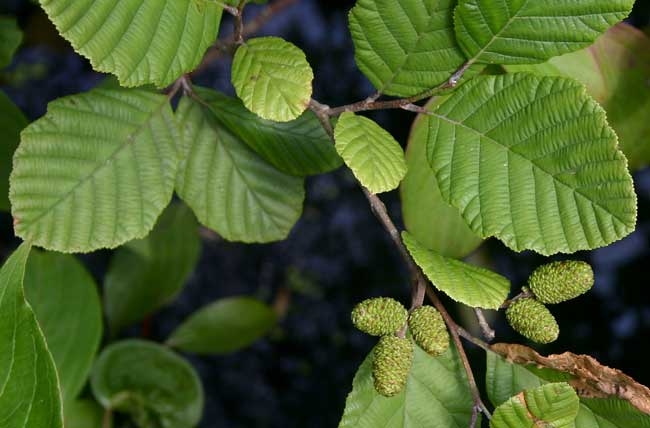Manchurian Alder
(Alnus hirsuta)
Manchurian Alder (Alnus hirsuta)
/
/

Quadell
CC BY-SA 3.0
Image By:
Quadell
Recorded By:
Copyright:
CC BY-SA 3.0
Copyright Notice:
Photo by: Quadell | License Type: CC BY-SA 3.0 | License URL: http://creativecommons.org/licenses/by-sa/3.0/ | Uploader: Quadell | Publisher: Wikimedia Commons | Title: Alnus_incana_rugosa_leaves.jpg | Notes: Preparing upload using [[User:Flickr upload bot|Flickr upload bot]] |






























Estimated Native Range
Summary
Alnus hirsuta, commonly known as Manchurian Alder, is a deciduous tree native to riparian zones, wetlands, and moist forest areas in East Asia, including regions of Siberia, Korea, and Japan. This species typically grows to a height of 15–20 meters (49–66 ft) and features smooth grey bark that remains unridged even in maturity. Its lifespan can extend from 60 to 100 years. The leaves are matte green, ovoid, and measure 5–11 centimeters (2–4+1⁄4 in) in length and 4–8 cm (1+1⁄2–3+1⁄4 in) in width. Manchurian Alder is notable for its early spring catkins; the male catkins are pendulous, measuring 5–10 cm (2–4 in) long, while the female catkins are smaller at 1.5 cm (5⁄8 in) long and 1 cm broad when mature in late autumn. The seeds are small, light brown, and feature a narrow encircling wing.
Manchurian Alder is valued for its ability to stabilize soil and improve nitrogen levels, making it useful for reforestation and ecological restoration projects. It is also cultivated for ornamental purposes in parks and gardens, particularly the ’Aurea’ cultivar with its attractive green-gold leaves, which has earned the Royal Horticultural Society’s Award of Garden Merit. The tree thrives in full sun and can adapt to a wide range of water conditions, from low to high, and is tolerant of various soil drainage types, including standing water. However, its shallow root system can lead to vigorous production of both stump and root suckers, which may be problematic in some settings.CC BY-SA 4.0
Manchurian Alder is valued for its ability to stabilize soil and improve nitrogen levels, making it useful for reforestation and ecological restoration projects. It is also cultivated for ornamental purposes in parks and gardens, particularly the ’Aurea’ cultivar with its attractive green-gold leaves, which has earned the Royal Horticultural Society’s Award of Garden Merit. The tree thrives in full sun and can adapt to a wide range of water conditions, from low to high, and is tolerant of various soil drainage types, including standing water. However, its shallow root system can lead to vigorous production of both stump and root suckers, which may be problematic in some settings.CC BY-SA 4.0
Plant Description
- Plant Type: Tree
- Height: 20-30 feet
- Width: 15-25 feet
- Growth Rate: Moderate
- Flower Color: N/A
- Flowering Season: Spring
- Leaf Retention: Deciduous
Growth Requirements
- Sun: Full Sun
- Water: Medium
- Drainage: Fast, Medium, Slow, Standing
Common Uses
Bee Garden, Bird Garden, Butterfly Garden, Drought Tolerant, Erosion Control, Low Maintenance, Rabbit Resistant, Water Garden
Natural Habitat
Native to riparian zones, wetlands, and moist forest areas in East Asia, including regions of Siberia, Korea, and Japan
Other Names
Common Names: Siberian Alder
Scientific Names: , Alnus hirsuta, Alnus sibirica, Alnus hirsuta var. sibirica, Alnus incana subsp. hirsuta, Alnus inokumae, Alnus hirsuta f. sibirica, Alnus tinctoria, Alnus hirsuta var. microphylla, Alnus hirsuta f. inokumae
GBIF Accepted Name: Alnus hirsuta (Spach) Rupr.